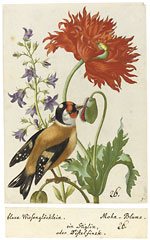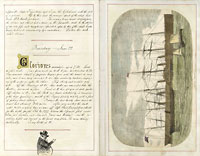 Ian McKay’s weekly column in Antiques Trade Gazette has been running for more than 30 years.
Ian McKay’s weekly column in Antiques Trade Gazette has been running for more than 30 years. Full Color
From Merian's Blumenbuch to Fibonacci’s rare manuscript and children’s illustration art, summer sales were vibrant
A Unique Blumenbuch?
It was only recently, in my Record-Breaker column in the summer quarterly of FB&C, that I recorded the sale at $234,850 of a copy of Merian’s … Insectorum Surinamensium in a Galerie Koller of Zurich sale of April 2, but now that short-lived Swiss record for any of Merian’s natural history collections has been not so much broken as completely demolished.
Here was a recently discovered and apparently unique survivor of the true first edition of Sibylla’s first and rarest work. Produced as a model book, providing patterns to be copied in painting or embroidery, it was originally issued in three parts, each with title page and a dozen plates, in the years 1675-80, and in that final year a composite of all three fascicules was also issued as the Neues Blumenbuch.
This set, however, comprised those three original parts, and though the plates and introductory text leaves are now trimmed and mounted on loose sheets—to which numbers and German captions with plant names have been appended in an eighteenth-century hand—they may never have been bound. This Blumenbuch was acquired at the time of publication by a member of the von der Osten family of Schloss Plathe in Pomerania, and the only surviving catalogue of that library shows that by 1900 it was already in this form.
No other complete copy is known and only five examples of the individual fascicules. What is more, the coloring closely resembles that found in incomplete copies of the Blumenbuch in London and Dresden that are considered to have been colored by Merian herself.
Of that 1680 Neues Blumenbuch, only six copies are recorded (three of them colored) plus a unique set of counterproof plates—again thought to have been colored by Merian herself—which sold for £168,750 (then $254,815) at Christie’s in 2000.
With all this in mind, an estimate of around $100,000-150,000 may look to have been distinctly conservative—and so it proved!
Victorian on the Rails
A Victorian traveler’s journal, £920 ($1,500) at Thomson Roddick & Medcalf of Carlisle on May 26.
This vivid and engagingly written and illustrated journal was compiled by a Victorian traveler who in 1869 made a “A Voyage to Gibraltar and the Opposite Coast of Spain,” and in the following year journied, second class, by train and mail cart from London to John o’Groats, the far northeastern tip of Scotland.
What distinguishes his one hundred and twenty-page journal is not the fine calligraphy, nor the original drawings, steel engravings, maps, and assorted ephemera. It is the fact that, rather than dwell on the picturesque nature of the countryside or its grand and ancient buildings, it focuses instead on the little details that we in the twenty-first century now find so fascinating, even to the extent of describing meals taken.
The writer, who from a ticket tucked into the journal seems to have been named H. Short, also took a particular interest in the engineering marvels of his age, especially in the fields of travel and communication.
Quoted below is a piece in which he passes on his feelings about railway travel. Dickens himself would surely not have disowned such a passage.
”Railway travelling takes everything at a disadvantage … it presents everything the wrong side outwards. In cities, it reveals the ragged and smutty companionship of tumble-down outhouses, and mysteries of cellar and back-kitchen life, which was never intended for other eyes than those that grope in them by day or night … now the screech, the roar, and the darkness of cavernous passages under paved streets … now the dash and flash out into the light, and the higgledy-piggledy glimpses of the next five minutes. In a moment you are above thickly thronged streets, and the houses on either side, looking down into the black throats of smokey chimneys.”










